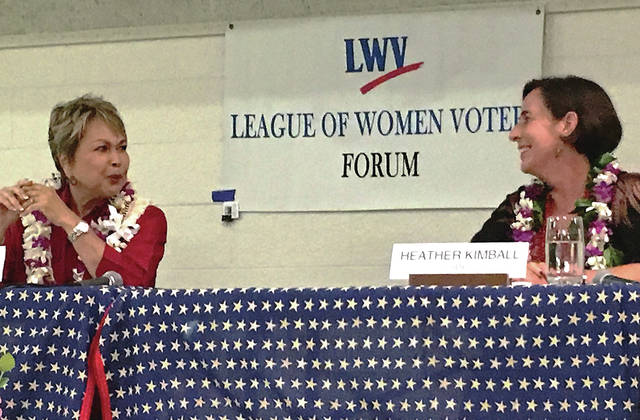HILO — Incumbent state Sen. Lorraine Inouye and challenger Heather Kimball faced off Monday night in a wide-ranging forum touching on repairing the Big Island’s post-eruption economy, shortages of doctors and teachers, cesspools, money in politics and making government more efficient.
Because there are no other candidates, the race will be decided in the Aug. 11 primary election on the Democratic Party ballot.
The sprawling Senate District 4 runs from Honolii, south of Saddle Road and all the way across the northern half of the island to Keahole Point in North Kona.
Inouye touted her record in “bringing home the bacon” in delivering on her priorities of schools, agriculture and transportation infrastructure, while Kimball pushed for more equitable funding for neighbor islands, environmental resilience and more efficient government, during the forum sponsored by the League of Women Voters of Hawaii County.
Inouye, 78, of Paukaa, has a long career in government, including as Hawaii County mayor and more than a decade as a state senator. She currently chairs the Senate Transportation and Energy Committee and sits on the Ways and Means Committee and Water Land Committee.
Kimball, 46, of Papaikou, is a scientist, planning consultant focusing on land management, carbon mitigation and climate change adaptation policy and former Sierra Club chairwoman.
Islandwide ramifications of the Kilauea eruption and lava inundation in lower Puna demand both quick and long-term solutions, the two candidates agreed.
Inouye said, as Transportation Committee chairwoman, she received first notice of the plans by Norwegian Cruise Line to halt its stops in Hilo and Kailua-Kona. The cruise line has since resumed service.
“Immediately, I sent a letter and cced the governor and everyone else who was involved,” Inouye said. “The message was, ‘please consider returning. The entire island is not devastated; we have safe harbors.’”
Inouye said she continues to work with the visitor industry to push for marketing to get the open-for-business message out.
Kimball said the current crisis is just one of many emergencies that can hit the isolated island. She pushed for a diversified economic base to better withstand isolation by hurricanes, tsunamis, lava flows and shipping strikes.
“Being an isolated state as we are, we are always vulnerable .. because we are so dependent on tourism and real estate development for our economy, we are vulnerable,” Kimball said. “We need to diversify. … We need to build our economic diversity so we can build our resiliency.”
On providing housing for those displaced by the lava flow, both candidates agreed that relocating displaced residents to state land that’s less likely to be inundated is a good idea. Kimball said communities could be made more effective with a strategic plan upfront.
Inouye said the county should be able to tap into the $570 million in affordable housing money recently passed by the Legislature.
“The state already has lands; there’s already discussions about relocation,” Inouye said. “The county should itself be clear there will be not allowed any more building in lava zones 1 and 2.”
Inouye said homeless people who were not made homeless by the lava flow had moved into the Pahoa shelter and should be moved back to Hilo. She said local churches should be asked to help find housing for them.
The issue of more efficient government is important to Kimball, and Inouye said she’s been working along that track as well. Creation of an airport authority has long been an issue she’s championed, she said, as an example.
“Where government doesn’t do a good job, they should get out of the business,” Inouye said.
Kimball countered that making government more efficient through technology is also important. She said some agencies still rely on paper forms, and moving to the digital world could help them run more cheaply and efficiently. Giving agencies the resources to become efficient would go a long way, she said.
“If you continually under-fund government services so they are inherently inefficient and ineffective — there are some things the government should do and could do well with planning,” Kimball said.




It is very significant when an incumbent State senator, in the phase of re-election, says “The county should itself be clear there will be not allowed any more building in lava zones 1 and 2.” Perhaps this will be provide the impetus necessary for the County admin and policymakers (Council members) to actually discuss this “no touch, I ain’t gonna say it” position.
It’s going to be very important to understand the differences between volcanic (not just lava) hazard zones 1 and 2. VHZ 1 is like swimming in a shark tank; VHZ 2 is like swimming in ocean with sharks known to favor the area among others. VHZ 2 includes the west half of Ka’u (includes all of HOVE and Ranchos), and South Kona up to Honaunau (approx.). VHZ 3 is like swimming in Kailua Bay; yes, there’s sharks occasionally, but not a practical problem there barring a major shift in circumstances.
Perhaps rather than outright ban dwellings in VHZ 2, homes should be required to be modular and trailerable and accessible with tractor-trailer rigs. At least that’s an option versus ignoring the threat or being draconian about a complete ban there. VHZ 1 is a different story; perhaps best to leave it for farming or low-density lodging where people can visit but not reside (e.g., Kalani Honua in lower Puna). That would allow for quick, easily managed evacuations and losses, while still heartbreaking for so many involved, that don’t require public bail-outs.
I couldn’t stop laughing when all I was hearing was government MO government and then MO GOVERNMENT to solve every social ill and economic problem. These liberal socialists never met a TAX they didn’t like, but remember it’s for our own good…when government SPENDS YOUR hard earned $$$…cause they know better than you how to SPEND YOUR MONEY.